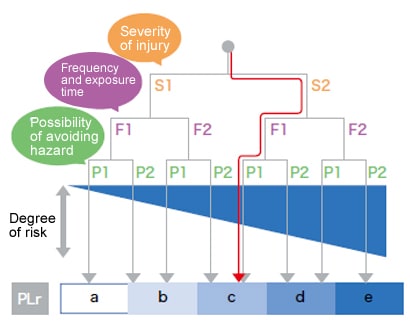| Performance Level (PL) |
Probability of Dangerous Failure per Hour (PFHd) 1/h |
|---|---|
| a | ≥10-5 and <10-4 〈0.001% to 0.01%〉 |
| b | ≥3 × 10-6 and <10-5 〈0.0003% to 0.001%〉 |
| c | ≥10-6 and <3 × 10-6 〈0.0001% to 0.0003%〉 |
| d | ≥10-7 and <10-6 〈0.00001% to 0.0001%〉 |
| e | ≥10-8 and <10-7 〈0.000001% to 0.00001%〉 |
The performance level (PL) is a value used to define the ability of safety-related parts of control systems to perform a safety function under foreseeable conditions. On the other hand, the required performance level (PLr) is used in order to achieve the required risk reduction for each safety function. Therefore, the performance level (PL) of safety-related parts of a control system must be equal to or higher than the required performance level (PLr).
For each safety function to be carried out by a safety-related parts of a control system, the required performance level (PLr) must be determined, which is based on the following three parameters:
